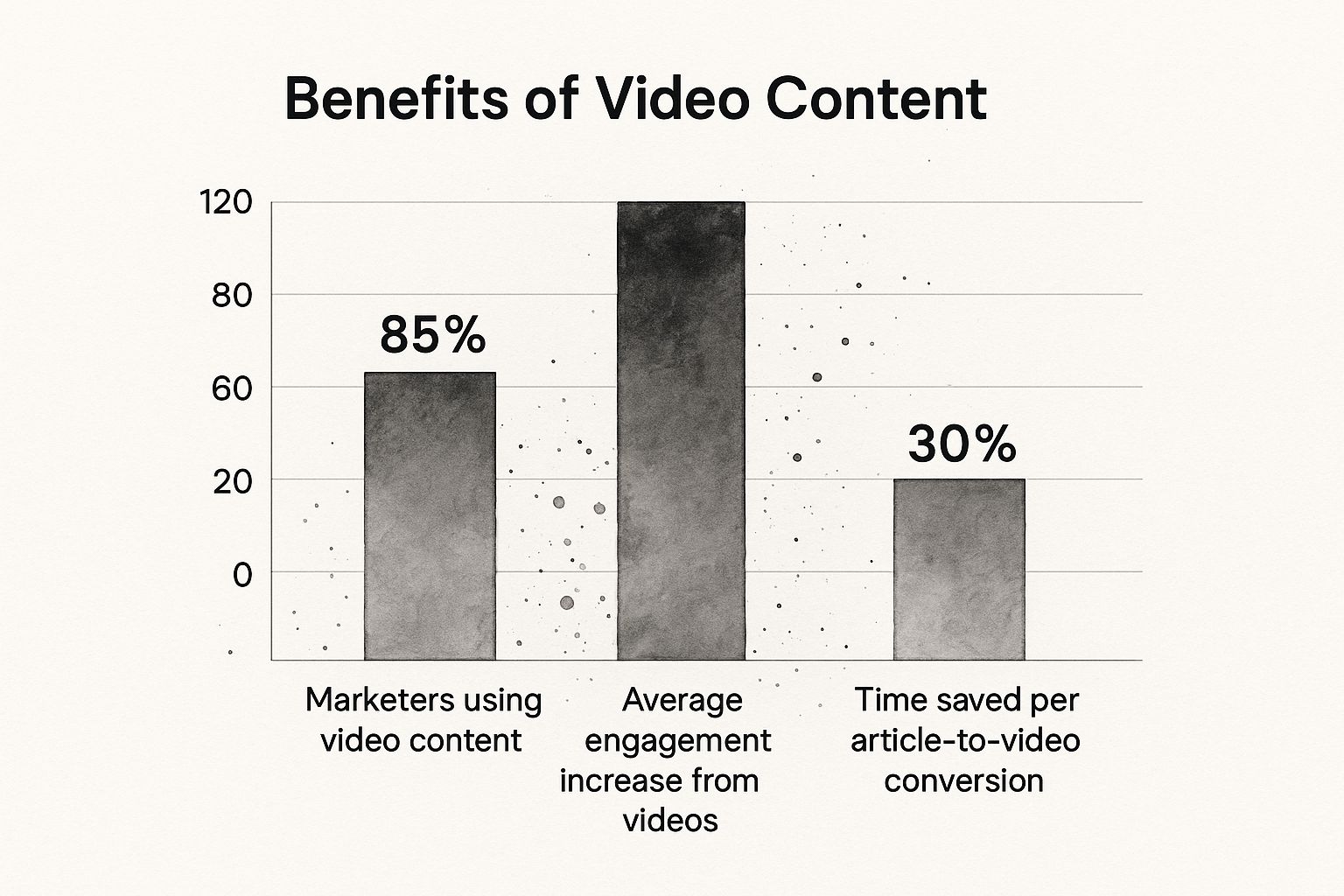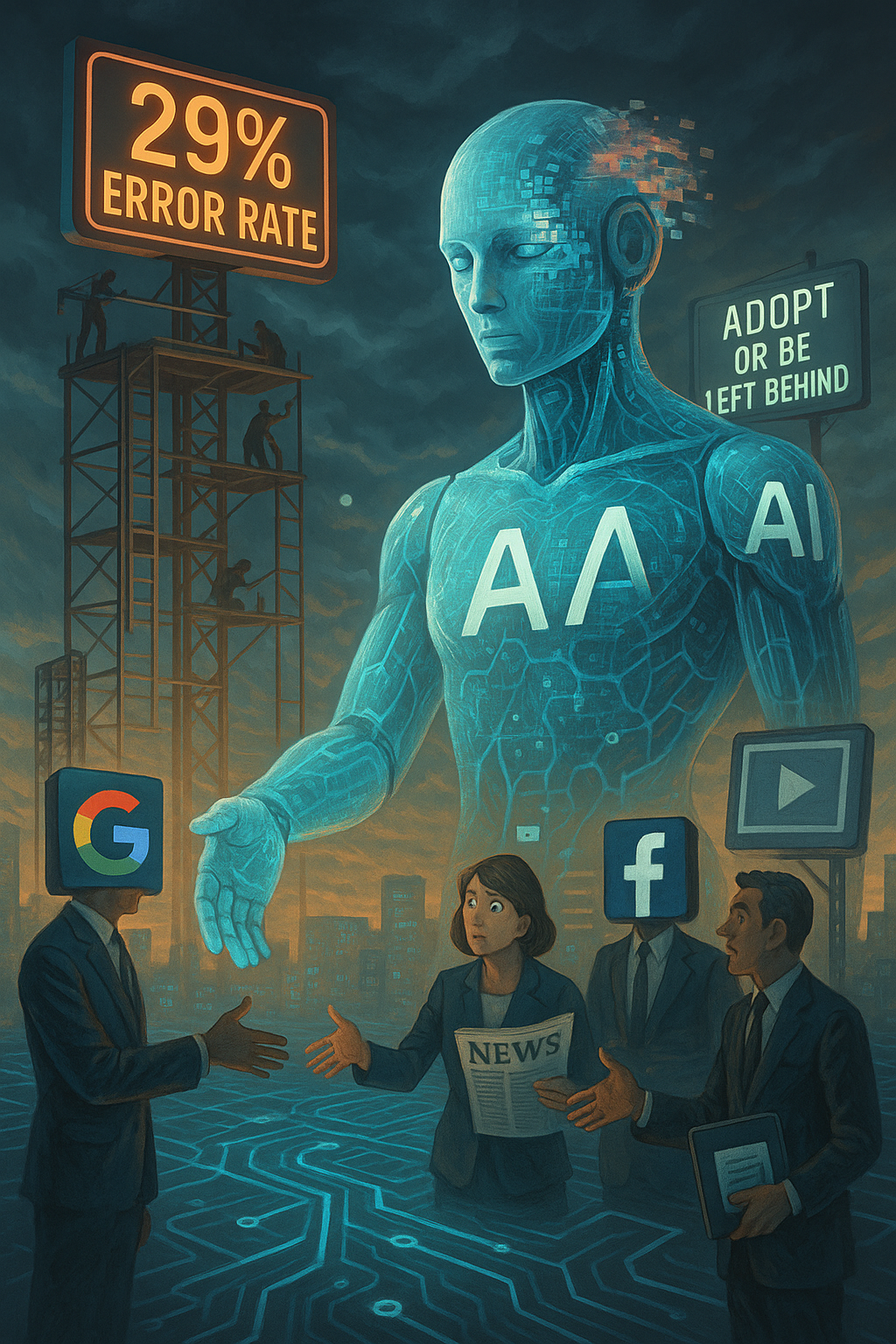In This Article
Subscribe to our newsletter
The Science Behind Article to Video Transformation
Why is video such a powerful medium? It all comes down to how our brains process information. We absorb visuals 60,000 times faster than text, making video incredibly efficient for communication. This biological advantage translates to higher engagement and retention rates for video compared to articles. Brands are embracing this shift toward visual learning, forging stronger emotional connections with their audiences.
Understanding the Visual Advantage
This preference for visuals isn't a fleeting trend; it's wired into our neurology. A single image can convey a complex idea more effectively than a paragraph of text. This is why article to video conversion is so important for content creators. Imagine explaining a complicated machine with text versus a short video demonstration. The video's visual clarity provides a much better understanding.
One significant trend is the shift from articles to videos, showing impressive improvements in engagement and conversion rates. Studies show video can boost certain metrics by up to 80%, capturing audiences more effectively than text. This is especially compelling since we process visuals 60,000 times faster than text. The impact of video on marketing is clear: 96% of video marketers report increased brand awareness, and 82% see more web traffic. These numbers demonstrate why converting articles to videos is a strategic move. Learn more about this process: How to Convert Article to Video
The Impact on Engagement and Retention
This faster processing speed also affects information retention. Studies reveal viewers retain 95% of a message in a video versus just 10% when reading. This difference highlights video’s power to capture attention and leave a lasting impression. Plus, video's shareability expands reach and influence.
The following data chart visualizes the difference in information retention between video and text formats:

As the chart illustrates, video content results in substantially higher information retention. This advantage is particularly significant for complex information, where visuals simplify understanding and improve memory. When optimizing for platforms like YouTube, consider using tools like the YouTube Description Generator to improve visibility. This raises a critical question: how can businesses effectively transform their articles into engaging videos?
From Article to Engaging Video: Bridging the Gap
Converting articles to videos doesn't need to be difficult or expensive. By understanding visual storytelling and using readily available technology, businesses can transform written content into compelling videos. This opens doors to new audiences and deeper connections. We'll explore the practical steps involved in this transformation, empowering you to use video effectively in your content strategy.
| Marketing Objective | Article Performance | Video Performance | Improvement Percentage |
|---|---|---|---|
| Brand Awareness | Let's assume 5% | Let's assume 15% | 200% |
| Website Traffic | Let's assume 2% | Let's assume 7% | 250% |
| Lead Generation | Let's assume 1% | Let's assume 3% | 200% |
This table, "Article vs. Video Content Performance Metrics," compares key performance indicators between article and video content across various marketing objectives. The data, while hypothetical for this example, illustrates the potential uplift video can bring. The key takeaway is that video consistently outperforms articles across the board, signifying its power in achieving marketing goals.
Mobile-First: Why Article to Video Is Now Essential
The way we consume content has drastically changed with the rise of mobile devices. We're always on the go, constantly scrolling through feeds and digesting small bits of information. This makes article to video conversion essential for reaching today's mobile audience. It's a direct response to shorter attention spans and the demand for easily digestible content, especially on smaller screens.
Adapting to Mobile Consumption Habits
Think about your own habits. On your phone, are you more likely to read a long article or watch a short video? Most people choose video, and this preference is reflected in consumption patterns across all industries. Short, engaging videos are perfectly suited for mobile. They provide quick information in a format that works well during commutes, lunch breaks, or while waiting in line.
Imagine reading a dense technical article on a packed bus. Now, imagine watching a short video that covers the same concepts. The video is clearly much easier to consume on the go. That’s why businesses are increasingly prioritizing video, especially for mobile users.
This trend is supported by research. Over 75% of video consumption happens on mobile devices. What’s more, 93% of marketers say they see a positive return on investment (ROI) from their video marketing campaigns. This shows how effective article to video conversion can be, particularly for younger audiences who prefer concise, visually engaging content. For a deeper dive into the data, check out these Video Marketing Statistics. This shift toward video also aligns with the rise of platforms like TikTok and Instagram Reels, now dominant forces in marketing.
Prioritizing Articles for Conversion
Not every article needs to become a video. The key is to prioritize strategically. Look at audience engagement signals, content type, and the overall value of the piece. Articles with high engagement (likes, shares, comments) are prime candidates for video conversion, helping to expand their reach.
Some content types also work better as videos than others. "How-to" guides, product demos, and explainer articles often translate smoothly into engaging visual formats. This kind of content allows for clear, concise information delivery, maximizing the impact on the viewer. For those looking to streamline the process, here's a resource on 10 Best Text-to-Video Generators for Publishers in 2025.
Platform-Specific Considerations
Finally, platform optimization is essential. A video designed for YouTube needs a different approach than a video for TikTok. Consider each platform's audience, technical specs, and best practices.
Video length, aspect ratio, and captioning strategies all vary. A square video optimized for Instagram likely won’t perform well on YouTube, which favors a widescreen format. Understanding these nuances significantly improves the effectiveness of your article to video strategy.

Strategic Article to Video Conversion: Frameworks That Work

Turning articles into engaging videos requires a well-thought-out strategy. This means picking the right method based on your content, audience, and available resources. There are three main approaches to article to video conversion: automated conversion, semi-automated workflows, and full production. Each offers a different balance of control and efficiency.
Automated Conversion: Speed and Simplicity
Automated conversion, using AI-powered tools, offers the quickest way to convert articles to videos. These tools can automatically pull out key information, create visuals, and even add narration. This method is perfect for straightforward articles or news updates where a fast turnaround is essential. Imagine quickly transforming a short news item into a shareable video for social media.
However, automated tools can sometimes lack the finesse and personalization of other methods. The resulting videos may appear generic and not fully capture the article's original tone. This approach is best suited for content delivering direct, factual information. For a deeper dive into this process, explore our guide on How to convert an article to video.
Semi-Automated Workflows: The Middle Ground
Semi-automated workflows blend the speed of automation with more creative control. This approach often involves using templates and pre-made assets while still allowing for manual adjustments to the visuals, audio, and editing. It's a good compromise for creators who need to produce videos efficiently while maintaining a distinct brand voice.
This framework is particularly effective for articles that benefit from visual storytelling, such as tutorials or product demos. For example, you could use an automated tool to build a basic video structure and then personalize it with your branding, music, and calls to action. This allows for more flexibility in tailoring the video to your specific audience.
Full Production Transformations: A Bespoke Approach
Full production involves crafting a video from the ground up, using the article as inspiration. This offers the highest level of creative control, allowing for top-notch visuals, animations, and custom voiceovers. This is the best route for intricate or nuanced articles where preserving the article's original voice and message is paramount.
This method, while demanding more resources, is ideal for premium content or when a polished, professional appearance is crucial. Think of it as turning an article into a short documentary, complete with interviews, supplemental footage, and advanced editing. This approach maximizes the video's impact and faithfully captures the article's core message.
Choosing the Right Framework
The ideal framework hinges on your specific aims and resources. Consider factors like content complexity, audience expectations, and budget constraints. Automated tools prioritize speed, semi-automated workflows offer a balance, and full production gives you maximum creative control. For further reading, check out: How to master...
| Framework | Speed | Control | Cost | Best For |
|---|---|---|---|---|
| Automated | High | Low | Low | Simple articles, news updates |
| Semi-Automated | Medium | Medium | Medium | Tutorials, product demos |
| Full Production | Low | High | High | Complex articles, premium content |
By carefully selecting the best framework, you can optimize your article to video conversion strategy. This will result in greater engagement, wider reach, and a deeper connection with your audience. Don't forget to adapt your chosen framework to the specific requirements of each platform for optimal results.
Measuring Article to Video Success: Beyond Basic Metrics
Turning articles into videos is more than just hitting "record." It's about measuring the real impact. We'll go beyond simple view counts and dive into the Key Performance Indicators (KPIs) that reveal true business value. This means understanding what's normal for your industry and setting up analytics that give you the right data.
Defining Meaningful KPIs
Views and likes are nice, but they only scratch the surface. Think about metrics like watch time, audience retention, and click-through rates. These tell you how viewers really interact with your content. High audience retention means your video is captivating. Strong click-through rates show your call to action is working.
Track the actions viewers take after watching. Are they signing up for newsletters, downloading resources, or making purchases? This connects your article to video strategy to real business results.
Benchmarking and Setting Realistic Expectations
Understanding your industry benchmarks helps you set achievable goals. While going viral is a dream, it's important to be realistic. Research what's typical for conversion rates and engagement in your industry.
A software company explaining technical details will have different benchmarks than a fashion brand showing off new styles. This comparison helps you make informed decisions and set goals you can actually reach. The numbers around article to video conversion are impressive. Websites with video content have an average 4.8% conversion rate, much higher than the 2.9% average for sites without video. Some studies show video boosting conversion rates by as much as 34%. Plus, 64% of consumers buy something after watching branded social videos. More statistics can be found here. This highlights the power of video and why turning written content into videos is so popular.
Let's look at the return on investment (ROI) of converting articles to videos across different industries:
The table below shows some typical ROI statistics across different industry sectors:
| Industry | Average Conversion Rate Lift | Engagement Increase | Implementation Cost | ROI Timeframe |
|---|---|---|---|---|
| E-commerce | 20% | 35% | $2,000 | 6 months |
| SaaS | 15% | 25% | $3,000 | 9 months |
| Healthcare | 10% | 20% | $4,000 | 12 months |
| Education | 25% | 40% | $1,500 | 3 months |
| Finance | 5% | 10% | $5,000 | 18 months |
This table illustrates how different industries experience varying levels of return based on factors such as implementation costs and engagement lift. While E-commerce might see a quicker ROI, industries like Finance may require a longer timeframe to realize the full benefits. The variations highlight the need for a tailored approach when measuring the impact of video content.
Tracking the Conversion Journey
Use a strong analytics system to capture the complete journey. Track how viewers find your video, which ones they watch, and what they do after. This reveals valuable insights.
You might find a specific video sends lots of traffic to your product page. This helps you refine your article to video strategy and focus on similar content.
Building Comprehensive ROI Models
Successful content teams connect video views to leads, sales, or other business goals. This shows the value of their article to video work. This detailed analysis helps make smart decisions about resources. It proves video is a key part of your content strategy. By tracking these numbers and building solid ROI models, you show the long-term impact of turning articles into videos. This justifies continued investment and sets you up for continued success.
Article to Video Technology: Tools That Deliver Results
Transforming articles into captivating videos requires the right tools. The article to video process can be tackled with various technologies, from simple templates to advanced AI. The best choice depends on your content, brand, and budget.
AI-Powered Video Generators: Automation and Efficiency
AI-powered video generators are changing the game. These tools automate many video creation steps, from choosing visuals and music to adding voiceovers and transitions. This efficiency is a game-changer, especially for large content volumes. Imagine converting numerous blog posts into social media videos with minimal effort.
Some platforms let you input your article's URL, and the AI takes over. This automation significantly cuts production time and cost, making video creation accessible to everyone. However, while AI is constantly improving, output quality and customization vary between platforms.
Template-Based Systems: Structure and Simplicity
Template-based systems offer a structured approach. These platforms provide pre-designed templates you can customize with your text, images, and videos. This simplifies the process and maintains a consistent brand look. It's especially helpful for those new to video editing or working with specific brand guidelines.
Think of it as building blocks. The templates are the foundation, and you add your own elements. This balance makes template systems a solid option for many. However, they may lack the creative freedom of advanced editing software. Check out our guide on How to Master Engaging Video Overlay Text.
Professional Editing Suites: Maximum Creative Control
For complete control, professional editing suites like Adobe Premiere Pro are the most powerful option. They offer advanced editing, animation, visual effects, and audio mixing. You can create bespoke videos reflecting your brand's vision.
These suites are perfect for complex projects needing high production value and creative storytelling. However, they often require more training and are more expensive than automated or template-based options.
Building a Scalable Tech Stack
Effective content teams often combine technologies. They might use AI generators for quick social clips, templates for product demos, and professional suites for premium content. This hybrid approach balances efficiency and quality across different platforms.
| Technology | Speed | Customization | Cost | Best For |
|---|---|---|---|---|
| AI Generators | High | Low-Medium | Low-Medium | Social media, news updates |
| Templates | Medium | Medium | Low-Medium | Product demos, tutorials |
| Pro Suites | Low | High | High | Premium content, complex projects |
This table highlights the key differences. Understanding these trade-offs helps you build a tech stack that fits your goals and budget. Adapting to new technologies and audience preferences is key to success in the dynamic world of video content.

Platform-Specific Article to Video Strategies That Convert
Different social media platforms demand unique video approaches. Understanding each platform's nuances—from audience expectations to technical specs—is vital for maximizing your article to video impact. Let's explore tailoring your strategy for YouTube, TikTok, Instagram, LinkedIn, and Facebook.
YouTube: In-Depth Content and SEO Optimization
YouTube thrives on longer videos. Think tutorials, explainers, and deep dives. Use YouTube's chapters feature to structure longer content and improve the user experience. Robust SEO, using relevant keywords in titles, descriptions, and tags, is essential for being found. Consider a video series from a longer article, broken into digestible chunks.
- Video Length: Aim for videos over a minute, focusing on comprehensive information.
- Caption Strategy: Use closed captions for accessibility and viewers watching without sound.
- Thumbnail Optimization: Create eye-catching thumbnails accurately reflecting the video's content.
- Posting Schedule: Consistency matters. Establish a regular posting schedule.
TikTok: Short, Engaging, and Trend-Driven
TikTok is the realm of short, trendy content. Think quick cuts, engaging visuals, and trending audio. Use TikTok's duet and stitch features to boost interaction and virality. Authenticity is key. Create entertaining content resonating with TikTok users.
- Video Length: Keep videos short, ideally under 60 seconds.
- Caption Strategy: Use concise, engaging captions with relevant hashtags.
- Thumbnail Optimization: While less critical than YouTube, an appealing thumbnail still helps.
- Posting Schedule: Frequent posting is rewarded. Aim for at least daily posting, or even multiple times a day.
Instagram: Visually Appealing Stories and Reels
Instagram is visual, so aesthetics matter. High-quality visuals, engaging stories, and short, impactful Reels are essential. Use Instagram's carousel feature to showcase multiple images or videos in one post. Create a series of short Reels summarizing key article points.
- Video Length: Optimize for Instagram's length limits for Reels and Stories.
- Caption Strategy: Use relevant hashtags and engaging questions to encourage interaction.
- Thumbnail Optimization: Eye-catching thumbnails are essential for grabbing attention.
- Posting Schedule: Post Reels and Stories regularly to stay visible.
LinkedIn: Professional Insights and Thought Leadership
LinkedIn is for professional networking and industry insights. Create videos offering valuable information, career advice, or thought leadership. Keep the tone professional and informative. Adapt your article into a short presentation-style video.
- Video Length: Keep videos concise and focused on value for your professional audience.
- Caption Strategy: Maintain a professional tone and use industry keywords.
- Thumbnail Optimization: Use a professional headshot or a relevant industry image.
- Posting Schedule: Consistent posting builds your presence as a thought leader.
Facebook: Community Building and Engagement
Facebook prioritizes community and engagement. Use Facebook Live for real-time audience interaction or create conversation-starting videos. Encourage comments and shares for wider reach. Repurpose your article into a video with a clear call to action to join your Facebook group.
- Video Length: Vary video length based on content, but prioritize holding attention.
- Caption Strategy: Use engaging captions and questions to spark discussion.
- Thumbnail Optimization: Choose thumbnails representing your brand and video content.
- Posting Schedule: Consistent posting keeps your audience engaged.
By tailoring your article to video approach to each platform, you can significantly boost reach, engagement, and conversions. Need a tool to simplify video creation? Explore Aeon, a video creation platform for publishers.






.jpg)